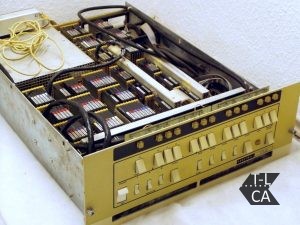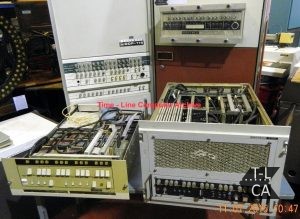The Honeywell 112 computer is 12-Bit, built in 1968 to compete with the Digital pdp8. The computer contained 8kbytes of RAM.
Much like the Honeywell DDP-516, the computer used Micropacks. These were plug-in modules which contained the logic IC’s used to create the computers ALU and IO section.
Also see Ian Spencers website.
The following story is Ian Spencer, Senior Lecturer at the Honeywell International School in London (Hammersmith) & Cologne.
It all started with the 'Computer Control Company' which was taken over by Honeywell and the 3C's designers had developed a 16 bit machine which they called the DDP-116. The first machines were built during the early part of 1965 and pretty much set the mould for the logical architecture of the whole of the Series 16 machines. Unlike the later machines it was built with things called S-Pac and T-Pac which were circuit boards which mainly used discrete components (transistors, resistors, capacitors etc.) but this first machine had the complete instruction set and architecture which would form the basis of all of Honeywells Mini's in the 1960's and 70's. That is it had a Program counter, an Accumulator and an Index register as well as a secondary accumulator called Register 'B' which had limited functionality. This machine was produced at about the same time as DEC was producing the first PDP-8 12bit machines.
When in 1966 Honeywell Computer Control Division developed the DDP-516 they kept the same instruction set and logical architecture from the 116 but built it completely from integrated circuits on boards they called u-pacs (micro-pacs) which were considerably smaller than the S and T Pacs used in the 116. Interesting is that they only used one type of logical gate and that is the NAND gate as it's possible to create all of the logical functions OR, NOR, AND and NAND with just NAND gates. The integrated circuits contained transistors and diodes and was called DTL logic (Diode Transistor Logic) All of the chips were designed to run from +6Volts.
The DDP-516 was very successful, although the PDP-8 from DEC took a good market share it's 12 bit architecture couldn't compete with the power of the 16 bit DDP-516 and it was the mini-computer of choice for those needing more power than the PDP-8 could provide.
To produce a cheaper machine Honeywell also introduced the DDP-416 which had lots of functions cut out of it to cut cost. Including the Index (X Register) and the B Register. But it was never very popular.
By 1968 technology had moved on and Honeywell simply built a new machine with basically the same structure as the 516 but using more advanced integrated circuits on larger boards. Which in effect made the machine smaller and cheaper and this was the very successful H-316. However it was quite a bit slower than the 516 and had some other limitations.
At around the same time as the H-316 was being produced Honeywell
developed their one and only 12 bit machine the H-112 which as it was meant for industrial use was called a controller rather than a computer but was in fact just a series 16 machine cut back to 12 bits like the PDP-8 and with a much reduced instruction set. The H-112 was not very successful simply being too late to compete with the established PDP-8 and was abandoned after about 2 years and never sold in large numbers. Interesting was that it was built using the DDP-516 u-pacs but with the memory modules from the H-316.
It was quite a long time before the next Series 16 machine appeared. That was in 1972 and I went to the Honeywell plant in Framingham Mass to learn how the new machine worked from the designers. It was the H-716 and I loved it but basically I believe Honeywell made a serious mistake with the design of the H-716. They kept it completely downwards compatible with the 516 and the 316 and this meant they had to keep the A Register/B Register architecture but computer design had moved on and DEC was developing the PDP-11, also a 16 bit machine but with a much more modern architecture using a whole bank of accumulators and index registers rather than just one (the A Register and the X Register). The old fashioned architecture of Series 16 just couldn't compete with DEC's PDP-11 and the H-716 was never a really successful machine. That said, as I mentioned I loved it. From an engineers point of view it was a super machine. It had in effect only one important timing signal 'T-PULSE'. and it controlled everything. So for example you could put an ADD instruction into the machine and some data into the A Register and move the machine to the 'Action' Cycle and with an oscilloscope you could see the answer of Register A plus Register M at the input to the A register and it would stay there for ever if you wanted it too and if anything was wrong you could simply take your time tracing it back. And you could change what was in Register A or Register M and see the result change at the inputs to the A Register. When you hit the start button T-Pulse changed and the answer was clocked into the A register. It was such an easy machine to trouble shoot.
All of the Series 16 machines had around 72 Instructions (except for the 416 with it's reduced instruction set). They all used ferrite core memory the 516 with a cycle time of 0.96uSecs, the 316 was slower with 1.6uSecs and the 716 was the fastest at about 0.75uSecs. The 516 and the 716 could have up to 64KW of memory whilst the 316 was restricted to 32KW. To allow peripherals to transfer data into memory faster and without the use of the CPU (allowing it to get on with doing other things). The 516 had DMA (Direct Memory Access) and DMC (Direct Multiplex Control) Options
The 316 had only DMC but as something a little faster was needed on occassion a HSDMC (High Speed DMC) was introduced.
Basically DMA was the most expensive option as it used the most hardware but allowed a peripheral to transfer data to memory in only 1 memory cycle. DMC used much less hardware but took 4 memory cycles per transfer and If I remember correctly HSDMC was a compromise between the two that took about 2.5 Memory cycles on average.
Other Hardware options were a RTC (Real time clock) providing interrupts in time with a 50hz clock and a High Speed Arithmetic option for those who wanted more speed than available with software arithmetic solutions and the extended Memory options for 32K and 64K of memory.
There were a selection of standard peripherals such as magnetic tape, Disk, Line printers and Card Reader/Punch devices available but paper tape was the most popular medium for loading and storing programs. Honeywell produced their own 300cps reader but the one we liked to use most was the FACIT reader which used capacitance read rather than optical and ran at 500 or 1000cps. 1000cps was most spectacular with the tape moving through the reader so fast that it shot horizontally out of the reader for 1 to 2 feet before dropping to the floor. However a tape jam was likely to completely destroy the tape and create chaos.
Series 16 was often used for communications as for example with the 1640 time share system and it had ASLC (Asynchronous Line controller) SSLC (Synchronous LIne controler) LCMLC and HCMLC (High Capacity Multi Line Controller) controllers, the first 2 controlled just a single asynchronous or synchronous line rather like the RS232 option in some PC's today but the LCMLC/HCMLC were multi line controllers and the HCMLC could communicate with up to 64 asynchronous (teletype devices) at the same time and there was even a special receive only version which could monitor 128 teletype lines at one time.
As they were all Software compatible the software from one series 16 machine would normally run without problem on another model.
Languages available were as standard :- DAP16 - the Series 16 assembler language and probably the most used language.
FORTRAN IV - Fortran 4 was also popular BASIC16 - A basic language interpreter (though Honeywell often called it a compiler it was in fact an interpreter) used a lot for playing games the most famous of which was the 18 Hole Golf simulation. Used a lot by salesmen demonstrating Series 16 to prospective customers, and a few non-standard languages not written by Honeywell, including FORTH and PL516.
All of the series 16 machines used something called a KIL (Key in
Loader) which occupied locations 1 to 17 octal of memory and read the first Bootstrap from an SLST (Self Loading System Tape) and the bootstrap which loaded starting at location 20 octal then loaded the program itself from the tape into memory. A majority of programs had octal 1000 as their starting address.
Assemblers and compilers normally produced their program output as
OBJECT tapes which could be loaded into memory with a program called LDR-APM or you could after loading a program into memory punch it out onto paper tape as an SLST (Self Loading System Tape) using a program called PAL-AP and these could be loaded with the Key In Loader.
Honeywell or Honeywell Bull as it was by then abandoned Series 16 in 1978 and moved on to Level 6 ( Also sometimes known as MINI6 and
System6) which had like the PDP-11 a more modern logical architecture but that's another story.



I remember the Honeywell 112. We had one in Air Force security service. It was used as an input to another computer system for training back in 1975 to about 1983 or so, in Goodfellow AFB, San Angelo, TX. I was a computer repairman working on 4 systems, all integrated or could be, if needed.
The good old days. I still miss it.